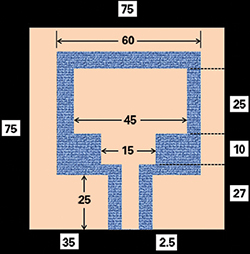
Figure 1 Textile antenna geometry with dimensions in mm.
A broadband T-shaped patch textile antenna with a coplanar waveguide (CPW) feed has a 10 dB return loss bandwidth from 1.8 to 3.8 GHz and good radiation patterns across the entire band with a maximum gain of 1.94 dBi. Return loss and radiation pattern differences are small when placed on a human body vs. free space, making it a promising candidate for WLAN and WiMAX wearable applications.
With an increasing interest in smart clothing and wearable wireless communication systems, a wide range of devices may be integrated into human clothing which can be useful for various wireless applications such as fire fighting, GPS, healthcare and personal satellite communication.1,2 In these applications, the antenna plays a vital role in system performance. Textile antennas, as a new antenna concept, are becoming more and more attractive for smart clothing due to their light weight and easy integration into everyday wear.3
Some recently proposed wearable antennas4-6 are either complicated or only able to cover a very limited bandwidth. Due to its inherently narrow bandwidth, bending of a conventional patch antenna in wearable applications can cause its resonant frequency to shift reducing power transmission efficiency. A coplanar waveguide (CPW)-fed antenna, on the other hand, has wider impedance bandwidth and consists only of a single conducting layer that is more convenient for wearable textile antenna fabrication and applications. This article will introduce a cost effective, high performance wearable CPW-fed textile antenna with ordinary fabric as the substrate. The antenna has a 10 dB return loss bandwidth from 1.8 to 3.8 GHz covering both WLAN and WiMAX bands, and a higher tolerance to twisting conditions on human clothing.
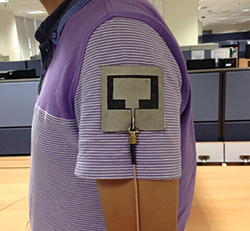
Figure 2 Arm-mounted wearable antenna.
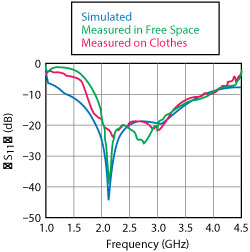
Figure 3 Wearable antenna simulated and measured return loss.
Antenna Structure and Design
To minimize performance degradation from deformation and fabrication tolerances, a microstrip patch antenna with a CPW feed structure is chosen (see Figure 1). It consists of two layers. The top layer is a conductive fabric and the bottom layer is a denim substrate with a relative permittivity of 1.6, loss tangent of 0.02 and thickness of 1 mm. Ordinary denim fabric is chosen as the substrate because it is flexible, lightweight, easy to integrate into clothing, stackable for different thicknesses, and most importantly it is a popular clothing material. Both materials are flexible and conformable. They can also be easily cut without special tooling. The textile antenna prototype is handcrafted by cutting the conductive fabric to the prescribed antenna geometry and then adhering it to the denim.

Figure 4 Measured radiation patterns at 1.8 GHz (a) 2.5 GHz (b) and 3.8 GHz (c).
The resonant frequency of the antenna can be estimated by Equation 1 which is a modification of an ordinary patch antenna design7
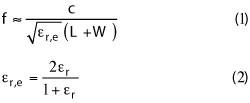
where c is the speed of light in air, εr,e is the effective dielectric constant, L and W are the inner length and width of the slot, respectively. The initial size of the antenna can be approximated by Equation 1. The gap between the feed line and the ground is chosen to create 50 Ω CPW, and the length and width of the T-shaped patch is used to tune the antenna’s resonant frequency and directivity. Parameters of the antenna geometry are optimized and a good return loss bandwidth is achieved using commercial field simulation software.8 Optimized dimensions to achieve an impedence match over a frequency range of 1.4 to 3.8 GHz are shown in Figure 1.
Simulated and Measured Results
When an antenna is attached to clothing it is not expected to be flat. Therefore, the return loss of the textile antenna on clothing is measured and compared with free space results. For on-body measurements, the textile antenna is placed on left upper arm, which is one of the most common wearable positions (see Figure 2).
Figure 3 compares measured with simulated return loss. The simulated 10 dB return loss bandwidth is 2.4 GHz (from 1.4 to 3.8 GHz with a fractional bandwidth of about 92 percent). The measured bandwidths are 2.1 GHz (from 1.8 to 3.9 GHz) in free space and 2.05 GHz (from 1.75 to 3.8 GHz) on-body, respectively. Good agreement is observed. Small discrepancies between the simulated and measured return loss curves that may be due to measurement error and fabrication tolerances.
Measured radiation patterns in free space and on-body at three points across the frequency band are compared in Figure 4. There are some differences likely due to the fact that the body’s tissues influence substrate permittivity, changing the antenna currents. Nevertheless, there is little change in maximum gain with a value of around 1.9 dBi. The results show that performance of the textile antenna when placed on-body is comparable to that of free space.
Conclusion
The design and performance of a wearable broadband CPW-fed textile antenna are presented. The antenna’s simple structure, wide impedance bandwidth and denim fabric substrate distinguishes it from previous wearable antennas. Return loss is greater than 10 dB across a 2 GHz bandwidth from 2 GHz from 1.8 to 3.8 GHz. Radiation patterns are comparable to those measured in free space.
Acknowledgment
The authors would like to thank the Chinese Scholarship Council for its financial support.
References
- S. Yan, P.J. Soh and G.A.E. Vandenbosch, “Wearable Dual-Band Composite Right/Left-Handed Waveguide Textile Antenna for WLAN Applications,” Electronics Letters, Vol. 50, No. 6, March 2014, pp. 424–426.
- E.K. Kaivanto, M. Berg, E. Salonen and P. de Maagt, “Wearable Circularly Polarized Antenna for Personal Satellite Communication and Navigation,” IEEE Transactions on Antennas and Propagation, Vol. 59, No. 12, December 2011, pp. 4490–4496.
- I. Locher, M.J. Klemm, T. Kirstein and G. Tröster, “Design and Characterization of Purely Textile Patch Antennas,” IEEE Transactions Advanced Packaging, Vol. 29, No. 4, November 2006, pp. 777–788.
- E.F. Sundaraingh, S. Velan, M. Kanagasabai, A.K. Sarma, C. Raviteja and M.G.N. Alsath, “Polygon-Shaped Slotted Dual-Band Antenna for Wearable Applications,” IEEE Antennas and Wireless Propagation Letters, No. 13, March 2014, pp. 611–614.
- Z.H. Jiang, D.E. Brocker, P.E. Sieber and D.H. Werner, “A Compact, Low-Profile Metasurface-Enabled Antenna for Wearable Medical Body-Area Network Devices,” IEEE Transactions on Antennas and Propagation, Vol. 62, No. 8, August 2014, pp. 4021–4030.
- E. Rajo-Iglesias, I. Gallego-Gallego, L. Inclan-Sanchez and O. Quevedo-Teruel, “Textile Soft Surface for Back Radiation Reduction in Bent Wearable Antennas,” IEEE Transactions on Antennas and Propagation, Vol. 62, No. 7, July 2014, pp. 3873–3878.
- K.W. Lui, O.H. Murphy and C. Toumazou, “A Wearable Wideband Circularly Polarized Textile Antenna for Effective Power Transmission on a Wirelessly-Powered Sensor Platform,” IEEE Transactions on Antennas and Propagation, Vol. 61, No. 7, July 2013, pp. 3873–3876.
- ANSYS HFSS, ANSYS Inc., www.ansys.com.

Qingshuang Liu received her B.Eng degree from China University of Mining and Technology, her M.Eng degree from Tianjin University, and is working toward her Ph.D. at Tianjin University. In August 2014, she completed a one year training period as postgraduate student co-cultivated by Tianjin University and Nanyang Technological University. Her research interests include passive radar, wearable antennas and metamaterial antennas.

Yilong Lu received his B.Eng degree from Harbin Institute of Technology, his M.Eng degree from Tsinghua University, and his Ph.D. from University College London. He joined Nanyang Technological University (NTU) in 1991, where he is currently a full professor in the school of electrical and electronic engineering. His research interests include radar, antennas, array based signal processing, computational electromagnetics and evolutionary computation for optimization of complex problems.
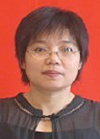
Jie Jin received her B.Eng degree, M.Eng degree and Ph.D. from Tianjin University. She joined Tianjin University in 2001, where she is currently a full professor in the school of electronic information engineering. Her research interests include antennas, laser techniques, optical components and optical communications.
